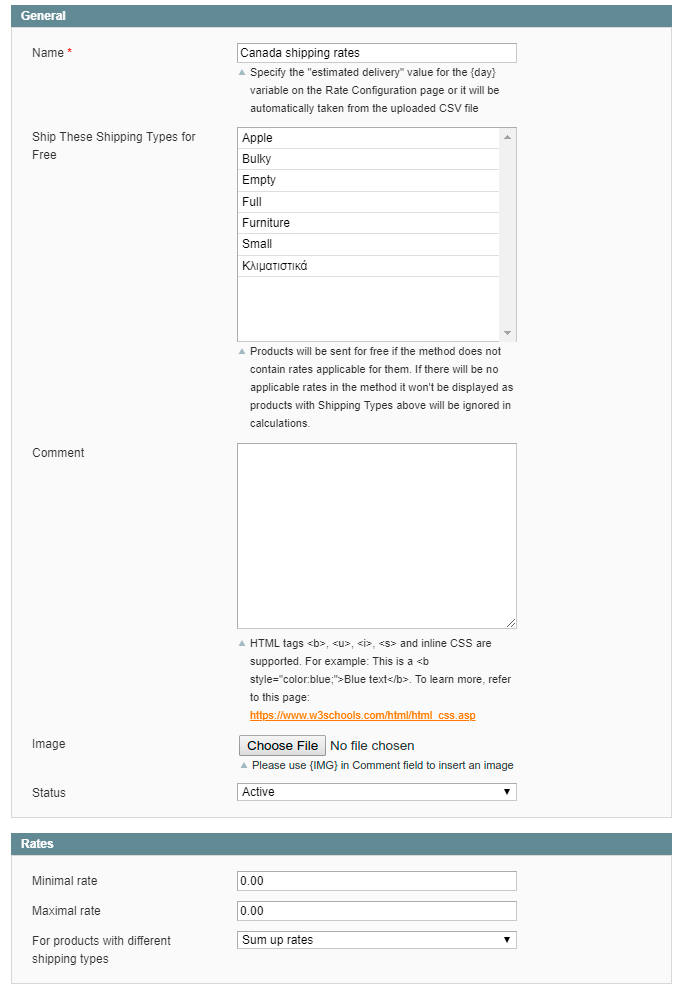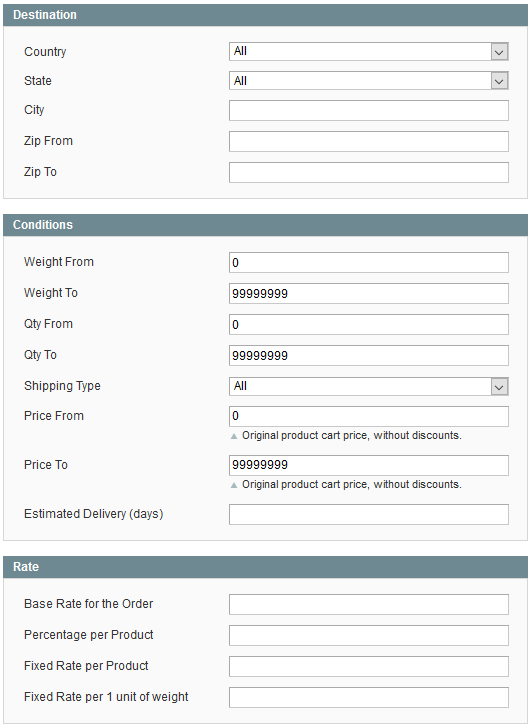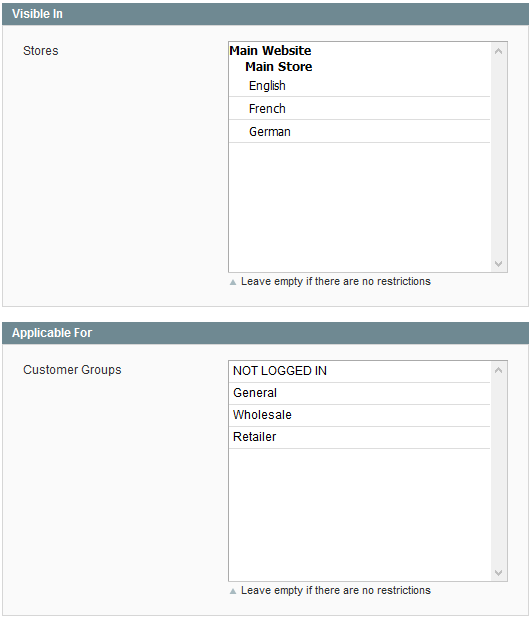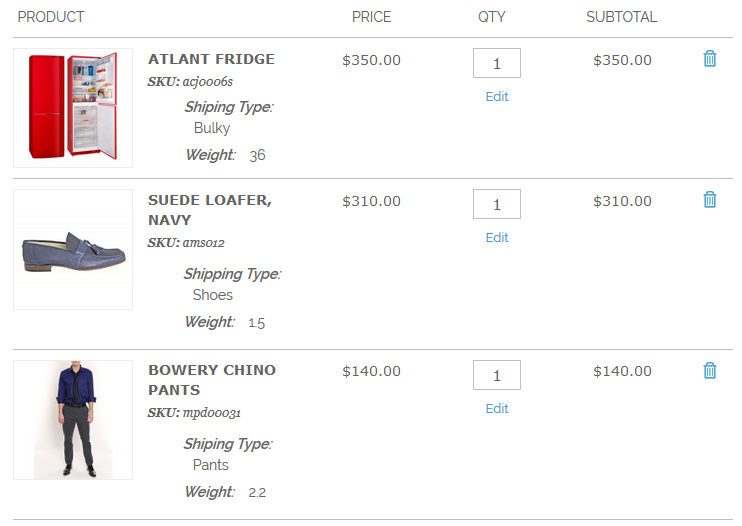Sidebar
magento_1:shipping_table_rates
Table of Contents
For more details see the Shipping Table Rates extension page.
Guide for Shipping Table Rates
Generate multiple shipping methods: flat rates, table rates, etc. Use combinations of address, weight, price, and quantity to calculate shipping.
- Specific rates for a product or a group of products
- Product type based rates
- Flat and percent rates; quantity and weight-based rates, etc.
- Automatic import and manual editing of shipping rates
- Estimated delivery dates display
- Support of Magento discount functionality
Troubleshooting checklist
- If Shipping Table Rates methods don't appear, please make sure that the shipping carrier is enabled in Magento settings at System > Configuration > Sales > Shipping Methods > Shipping Table Rates > Enabled
- Also please make sure that you've configured rates for all Shipping Types you have in the cart in the same shipping method. The shipping method will be displayed only if there are rates for all Shipping Types in the cart. You can try adding a new rate in the method without any conditions and with Shipping Types set to “All” to check if that was the problem or not.
- Rates are not summing up even if the setting in the shipping method is set to “Sum up rates”? Please make sure that the rates you want to be summed up are in the same shipping method. This setting determines what will happen to rates that have different Shipping Types in the same shipping method. All shipping methods you create work independently.
Shipping Type
Shipping Type is a complex feature which allows creating flexible shipping rate calculations. To learn more how the feature, please, read the article here.
Shipping Types options are created in Catalog > Attributes > Manage Attributes, find attribute labeled 'Shipping Type' and open it. Go to Manage Label/Options and create options for the attribute.

Then, go to the product settings and edit its shipping type.

And finally, you need to add a new rate for ‘furniture’ products to the shipping method. Go to Sales > Shipping Table Rates > choose the method > Methods and Rates > select a method or create a new one

Now to each product with Shipping Type='Furniture' will be added $50 to its shipping price.
General extension settings

- Enabled - the option enables and disables a shipping carrier completely for the selected store view.
- Title - the title of shipping carrier which will be displayed above the list with shipping methods.
- Ship to applicable countries - can be set to display shipping carrier methods only for selected countries.
- Ship to Specific countries - if the setting above is set to Specific Countries you will be able to specify the list of countries here.
- Displayed Error Message - an error message which will be displayed when no shipping method from the carrier can be applied to the order.
- Allow Free Shipping Promotions - the option controls whether Free Shipping from Shopping Cart Price Rules will be applied to shipping methods.
- Ignore Price and Quantity of Virtual Products - when the option is enabled, Virtual products' quantity and price won't be added to calculations when Price and Quantity conditions from rates are being validated.
- Compare postcodes as
- Numbers mode allows creating rates that can be applied to a range of alphanumeric postcodes, like in the United Kingdom. For example, you can set a postcode range like 'AB1 - AB12' and the extension will treat this range as twelve areas, applying the rate on postcodes like AB1 30W and AB11 42E alike.
- Strings mode will allow you to use a wildcard symbol '%' in postcode conditions. For example, we set a postcode condition like '35%', in this case, we will make the rule apply to postcodes like '35004', '359974', '351 ACC' and others.
- Use price AFTER discount - the option controls if the Price condition will be validated with or without a discount applied.
- Use price INCLUDING tax - same as for discount setting above, but for the Tax\VAT value.
- Sort order - controls where in the shipping carriers' list the Table Rate carrier will be displayed. The zero '0' value means 'the top of the list'.
- Use only one shipping type for shipping method - The option restricts rates application to carts with mixed content. When enabled, if there are products with different Shipping Types in the cart the rate with 'Shipping Types = All' will be applied instead.
- Show Method if Not Applicable - when enabled, the feature displays an error message instead of hiding the shipping method in case there are no applicable rates.
- Shipping Type for configurable products - controls the Shipping Type validation for Configurable products. It can be set to check the Shipping Type value of a parent Configurable product or an associated Simple product.
- Shipping Type for bundle products - same as the setting above. It also controls the Shipping Type validation but this time for Bundle products. It can be set to check a Shipping Type in a Bundle product itself, or in the Simple products inside the bundle. As in “Ship Bundle Items” setting option will check 'Ship Bundle Items' option in a Bundle product configuration. If it is set to Together the Shipping Type will be validated in a Bundle product. If the setting is set to Separately the Shipping Type validation will go to Simple products inside the bundle.
Volume weight settings
Volumetric or dimensional weight is a pricing method where an estimated weight is calculated from the length, width, and height of a package. With this option, a carrier can optimize the usage of the cargo space more efficiently.
Dimensional weight is calculated as (length × width × height) / (dimensional factor).
The shipping factor (DIM) is a number a carrier uses to assess the effective weight of a shipment based on its density. If a product has a volumetric weight, the extension compares it with a regular product weight and choose the biggest value for shipping cost calculations. The DIM factor is usually set by your courier company, so you should check it.
For example, we’re shipping 10 pounds each of bricks and feathers. 10 pounds of bricks can fit into a 10x10x10 box, making the volume of that box 1,000 cubic inches. If you divide the cubic inches by the DIM factor of 166 – your dimensional weight is about 6 pounds. Because this is lower than the actual weight of the package, the charge would be rounded up to the 10-pound rate.
The settings:
Volume weight - you can calculate a shipping price based on a volumetric weight in 4 ways: Volumetric weight attribute, Volume attribute, Dimensions attribute and Separate dimension attribute.
You choose 'Volumetric weight attribute' calculation method
Choose this method if you want to use the already calculated volumetric weight value. To that end, you need to create a volumetric weight attribute and specify the values for the items by yourself.

- Volume weight - Volumetric weight attribute
- Volumetric weight attribute - choose the volumetric weight attribute you've created previously.
————————–
You choose 'Volume attribute' calculation method
In this method, the volumetric weight is calculated based on the item's volume and shipping factor. Thus, you need to create a volume attribute, specify its values for products and specify a shipping factor.

Volume weight - choose 'Volume attribute'.
Attribute - choose the volume attribute you've created previously.
Shipping Factor - specify the value of the DIM factor. Use the DIM Factor published by your courier company to establish the dimensional weight
You choose 'Dimensions attribute' calculation method
In this method, the volumetric weight is calculated based on the item's dimensions. To use this option, you need to create one dimension attribute and specify this parameter for each item in the following way: height*length*width. And also you need to specify the shipping factor.

Volume weight - choose 'Dimensions attribute'.
Dimensions attribute - choose the dimensions attribute you've created previously.
Please mind that the value of the dimensions attribute should be specified in the following format: 12*34*45 or 12x34x45, where 12, 34 and 45 are the height, width, and length.

Shipping Factor - specify the value of the DIM factor. If you don't know it, ask your courier company.
You choose 'Separate dimensions attribute' calculation method
Choose this method if you have the attributes for each particular dimensions parameter like height*length*width. And don't forget to specify the shipping factor.

Volume weight - choose 'Dimensions attribute'.
Attribute 1, Attribute 2 and Attribute 3 - choose the attributes for volume parameters like height, width, and length.
Shipping Factor - specify the value of the DIM factor. If you don't know it, ask your courier company.
Shipping method settings
Shipping methods are located at Sales > Shipping Table Rates
General

- Name - the name of the shipping method which will be displayed in the list of shipping methods on cart and checkout. You can use the {day} variable here to output the text from the Estimated Delivery (days) column.
- Ship These Shipping Types for Free - products with Shipping Types selected here will be shipped for free when the method calculates rates for the order.
Please note that if there is only the product with the 'Free Shipping Type' in the cart, no shipping method will appear. To make it appear you should specify separate shipping rates for this particular Shipping Type or for the Shipping Type = All.
- Comment - this text will be displayed under the shipping method on cart and checkout pages. Safe HTML tags like b, u, i and others are supported.
- Image - upload an image for a shipping method. Please use {IMG} in Comment field to insert an image.
- Status - enables or disables shipping method.
- Minimal rate - minimal value the rate can have.
- Maximal rate - maximal value the rate can have.
- For products with different shipping types - can be set to:
- * Sum up rates to summarize rates for different Shipping Types in the cart;
- * Select maximal\minimal rate to use only the rate with maximal or minimal value for a specific Shipping Type when there are produces with different Shipping Types in the cart.
Labels
Stores & Customer Groups
- Stores - controls on which stores the shipping method will display.
- Customer Groups - restricts customer groups which will be able to use the shipping method.
Import
- Delete Existing Rates - if enabled, all existing rates will be removed when you try to save changes or import CSV with rates. Useful when you want to replace all the rates in the method with new ones from a CSV file.
- CSV File - here you can import a CSV file with rates. Here csv_example.zip you can download the sample CSV file with rates to check how the file is formatted.
Methods and Rates
- Country - the country for which the rate will be applied.
- State - State condition for the rate. Please, make sure that your Magento already has all the states you want to use in conditions in its database.
- City - City condition for the rate.
- Zip From - To - a specific postcode (when From and To values match or only From is filled) or postcode range. When it's filled like 'From: 35000 To: 35999' the rate will apply for all 1000 postcodes inside the 35000 - 35999 range. UK postcode format is supported.
- Price From - To - Price condition for the rate. Prices for products with the same Shipping Type will be summarized.
- Weight From - To - same as condition above, but works with Weight product attribute.
- Qty From - To - same as two above, but for product quantity in the cart.
- Shipping Type - default value “All” which means that the rate will be applied to all products. Please check Shipping Type section for more info on how this feature works.
- Rate - rate value of the whole order.
- PPP - Percentage per Product rate. Shipping will be calculated as a percentage of the product price.
- FRPP - Fixed Rate Per Product rate. It will be calculated multiplying products quantity in the cart by the value in FRPP field.
- FRPUW - Fixed Rate per Unit of Weight. The rate will be calculated based on the Weight of the product. For example, if FRPUW is set to 2.50 and Weight of the product in the cart is 4.55 then the calculation will be like this: 2.50*4.64=$11.6
- Estimated Delivery (days) - the text from this column will be inserted in the {day} variable which you can use in the Name field.
New Rate screen
When you hit Methods and Rates > Add new Rate button you will be presented with the following screen:
 Please check the description for all these fields at Methods and Rates section.
Please check the description for all these fields at Methods and Rates section.
How the rates are calculated
Let's say we've set up rates in our shipping method like this (click on the screenshot to see the example).
 Things to notice: we have active conditions Shipping Type, Weight and Country.
Things to notice: we have active conditions Shipping Type, Weight and Country.
Since we have a rate for specific Shipping Types, in this case, Shipping Type = Bulky, then this rate will go first. There are no additional conditions in the rate for Shipping Type = Bulky so our fridge will have this $100 rate assigned.
Now we have two products with different Shipping Types left. There are no rates for Shipping Types of these products in the method, but there are some rates with Shipping Type = All.
If there are no rates for some Shipping Type in the method but there is a rate for Shipping Type = All then products without matching Shipping Types will be treated as having Shipping Type = All. Please check the Shipping Type section for more info.
After that, we end up with two Shipping Types = All products in the cart, so their attributes like Price, Quantity and Weight will be summarized. Therefore, the extension will look for the rate matching these conditions: Qty = 2, Price = $450, Weight = 3.7.
In our rates, we have only the Weight product condition, and the very first rate which can be applied to the Weight range from 0 to 10 is a match for us. It costs $10 which we add to the $100 calculated for the fridge previously to have the total rate of $110
Finally, we have an active Country condition, so our rates will apply only if a customer selects to ship the order to the United States.
magento_1/shipping_table_rates.txt · Last modified: 2022/08/24 11:26 by azolotorevich





